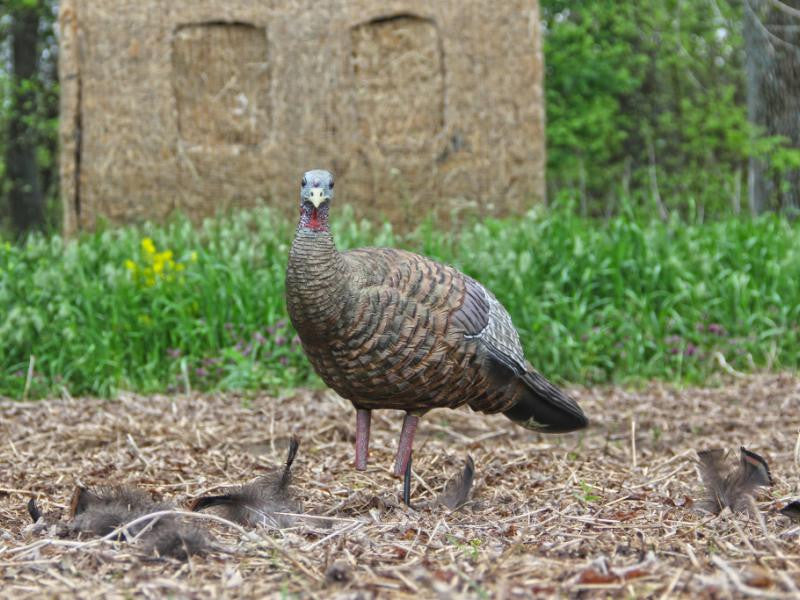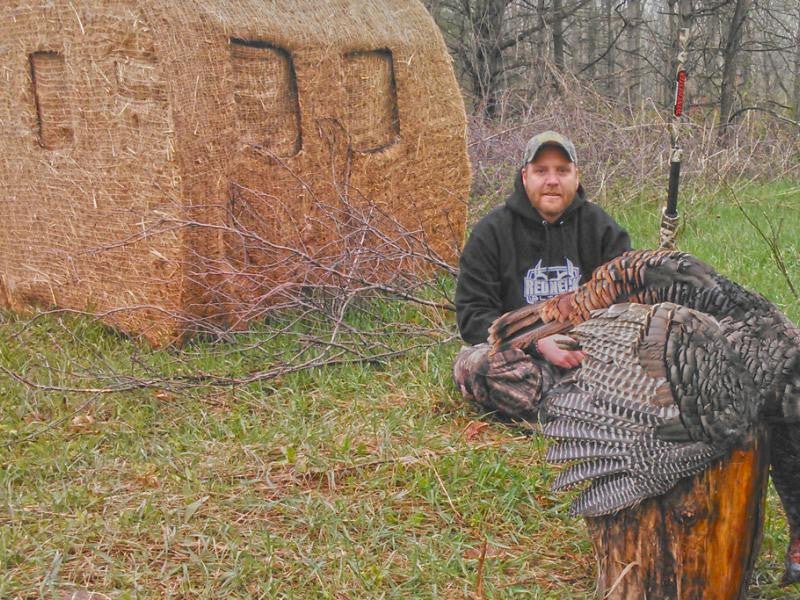
Turkey Hunting from a Bale Blind
5 min read
“Dad... I'm going to brush this blind in to make it look more natural.”
“Go ahead, buddy,” I replied. But in the back of my mind, I knew he didn't need to. We were setting up our Outfitter HD Hay Bale Blind for the upcoming turkey season, and I honestly couldn't think of a more natural setup. A round bale laying on its side in farm country is a pretty normal occurrence. Either way, this blind was going to be used by a lot of us in the spring, and if my son was excited to help, then I wanted to let him.
This spring, not only am I hunting, but I'm guiding a local Iraq War veteran as well as my own children. I love exposing people to turkey hunting, and I want the hunt to be a fun experience.
I’ve slogged through mosquito-infested swamps chasing gobblers, but I’d rather start a rookie in the comfort of a ground blind. The Bale Blind is perfect, with several windows to shoot from and lots of room to move—plenty of room for at least two adults and a restless kid or two.
When I first think about ground blind hunting for turkeys, I consider basic turkey behavior and location. Any tom worth his salt in the spring will be roosting with hens.
The Roost Phase
Throughout the day, I like to turkey hunt in phases. The first phase is what I call the roost phase. I get close to the roosted birds, but not directly under them. I try to get about 100 yards from where the birds roost and where I think they’ll walk to after they fly down.
Many birds try to fly down into the wind to best control their landing and away from the sunlight so they can see where they are landing. Once on the ground, though, their patterns tend to be the same.
At this particular farm, the birds like to roost along a river. They prefer to roost along the river because they feel safer seeing how there are only 180 degrees they need to scan for a predator coming at them vs. a full 360 degrees if they were roosted in the middle of the woods.
After Flying Down from Roost
Once the birds fly down from the roost along the river, they generally walk one of the two-track trails toward the tilled cornfield. At this particular farm, the birds tend to fly down, group up, and head to the field where they will breed, eat, strut, and spend the majority of their morning.
This blind that I set up is at the intersection of these two trails, just shy of the field. It is located in what I consider a high-traffic turkey area.
That being said, this is by no means an easy hunt. The turkeys will almost always be coming from behind us, crossing toward the front of us. Turkey hunting is hard enough, and without a blind, there's no way I could guide hunters into this spot. So as far as this farm goes, I think the location for this blind is perfect.
Food Sources, Water, Dusting Areas, and Travel Corridors
Other things to consider when setting up a ground blind are the location of food sources, water, dusting areas, and travel corridors. Any of these items would be a great spot to set up a ground blind.
The ground blind should be in a high-traffic area where turkeys could be approaching from any direction. The key to this hunting style is to conceal movement and not so much calling or decoying.

In the roost phase of my hunt, I like to arrive at my spot very early in the morning, before the songbirds are chirping. I like showing up this early just to be sure I know the roosted birds are still asleep.
During this phase one of my hunting day, I don't call a lot from this location or use any decoys, but rather just rely on the turkey’s natural patterns.
I'll hunt this setup till mid-morning, say 9 or 10 o'clock. If nothing has happened yet, and I don't have a bird nearby to work, I will leave the blind and start doing a little “run-n-gun” hunting.
Run-N-Gun Turkey
My run-n-gun hunting is how it sounds, I walk fast and call loud, trying to strike a lonely tom. I cover much ground this way and will generally run-n-gun from mid-morning to early afternoon.
It's important to know that in my home state of Michigan, we can turkey hunt from dawn to dusk. Other states do not allow evening turkey hunting. Be sure to check local regulations.

Using Decoys in the Afternoon
Around 1 or 2 o'clock, if my run-n-gun hasn't paid off yet, I return to the blind and put out a decoy. I will put at least one hen and maybe a Jake or Tom, depending on the mood of the other toms in the area.
If I think that they are aggressive, I will place the Jake or the Tom. If I think they are passive and do not want to fight, I will just leave a single hen. At this point, I will call every so often and hope to catch a lonely tom wandering around. If anything, I'm along the trails the animals will take to return to their roosts for the evening hunt.
Items in My Blind for Turkey Hunting
In my bale blind, I have a Redneck Portable Hunting Chair and a handful of other things. I bring a book, water, food, and my smartphone to play on. Often I will recline the chair all the way back, cross my arms, pull my hat down over my eyes, and catch up on some much-needed sleep.
There's not much better than an afternoon nap enjoying God's creation in the great outdoors. To be honest, I have gotten caught off guard this way. I opened my groggy eyes a few times to see live turkeys hanging around my decoys.
This always presents a humorous situation as I'm attempting to wake up, grab my gun, and make a shot. Once again, taking a nap and waking up to shoot a turkey would not be possible without a ground blind. If you’re like me and the outdoor nap is as much of a priority as a turkey fan on the wall, then by all means, get a ground blind!

As always, have fun this spring, and be safe. And when you shoot your big old gobbler out of a Redneck Blind, send us a picture. If you post the photo on Facebook or Instagram, use the hashtag #redneckblinds, and we might just show it off for you.
Good luck!
Leave a comment
Comments will be approved before showing up.

